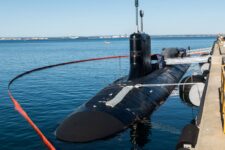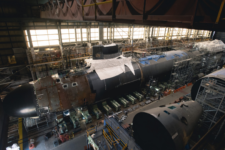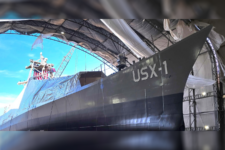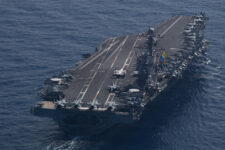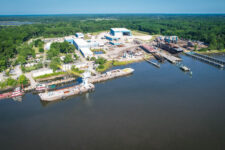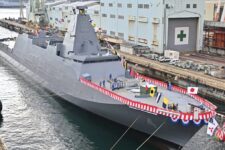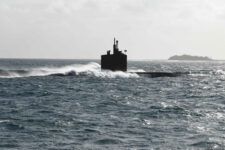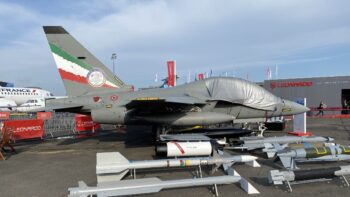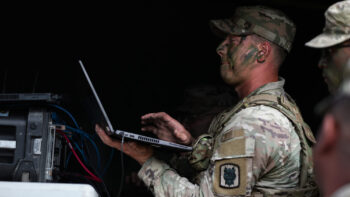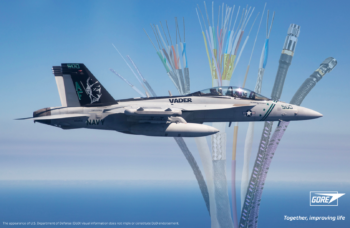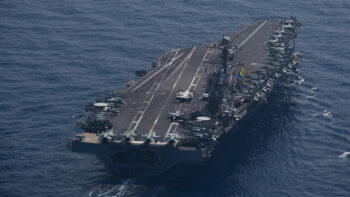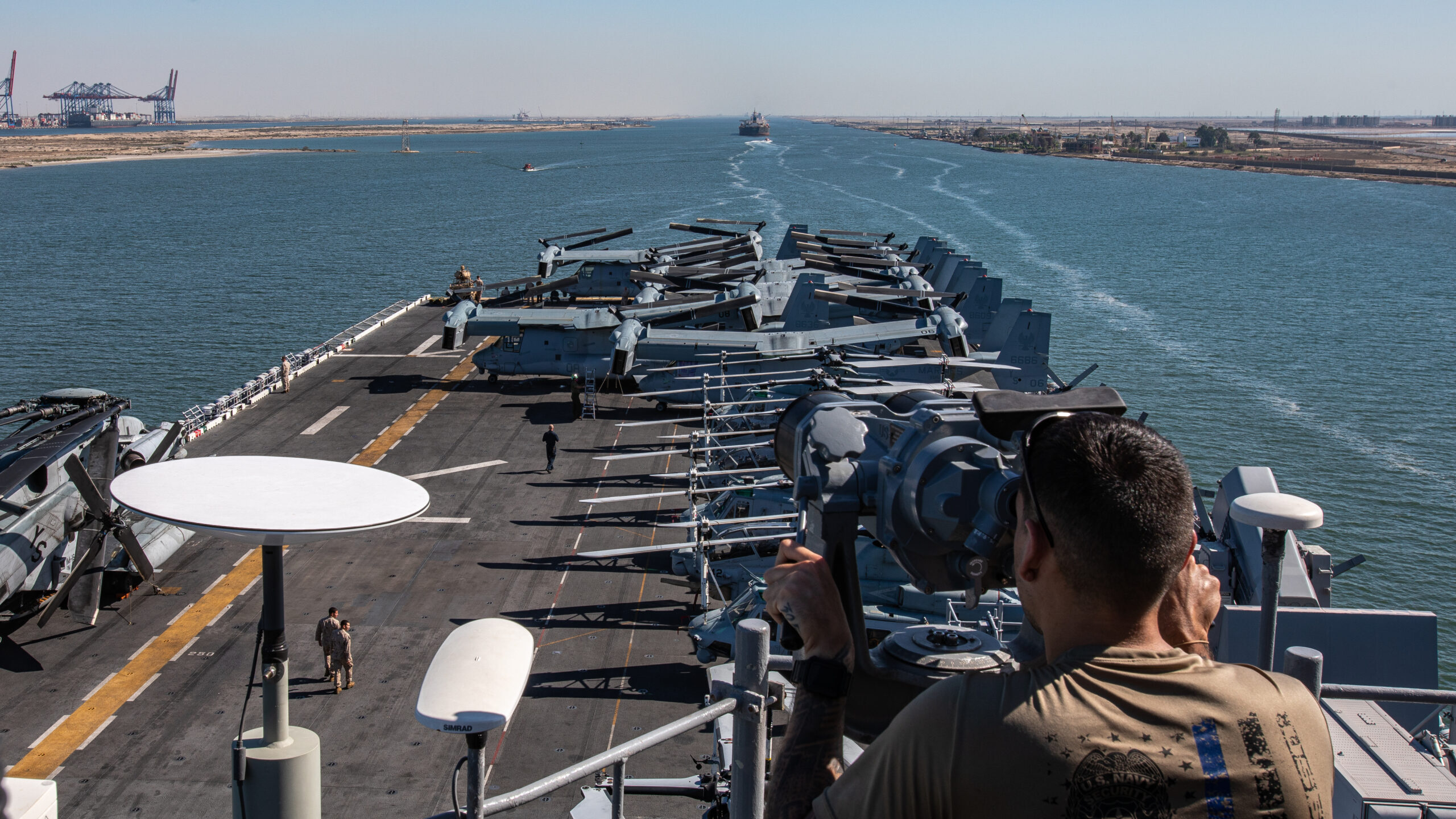
A US Navy sailor from USS Bataan (LHD 5) stands watch as the amphibious assault ship transits the Suez Canal with the 26th Marine Expeditionary Unit (MEU), Aug. 6, 2023.(U.S. Marine Corps photo by Cpl. Nayelly Nieves-Nieves)
Updated 8/10/23 at 3:47 pm ET to clarify plate supply chain issues.
WASHINGTON — A 3D printer onboard the amphibious ship Bataan (LHD-5) may have just saved the Navy a lot of money on an otherwise costly repair, and the service’s chief engineer says he plans to send similar printers to other ships and maintenance centers ashore in the coming months.
The part in question, a de-ballasting air compressor, lets the crew change the ship’s draft depending on the water depth in which they’re operating. To replace a defective unit, the service normally would be looking at a wait time of a little more than a year to get a brand new one, said Rear Adm. Jason Lloyd.
But after identifying a missing sub-component and using a 3D printer aboard the ship to build and test out a new one in June, Lloyd said the Bataan’s crew “got the wait time down to five days.” It also probably saved the Navy around $400,000, the service said.
In an exclusive interview with Breaking Defense, Lloyd revealed new details about how the Bataan took advantage of its 3D printing shop and the latitude the Navy’s engineers are now giving the fleet to fix their own vessels using additive manufacturing — a capability he wants to see grow in the coming years.
“Additive manufacturing and advanced manufacturing [are] really capabilities that we have to push out to the service. We don’t have within the United States the capacity that we had in World War II to do castings, that kind of stuff, to build the number of ships that we’ve got to build,” he said. “We’ve got to look at different technologies to get there, additive manufacturing being one of them.”
And if Lloyd has things his way, over the course of the next several years, metal and polymer 3D printers will reach “every regional maintenance center [and] every shipyard. Metal printers on the big deck amphibs and carriers and then polymer printers on the smaller ships.”
A 3D Printer Onboard With A Team On The Shore
In this recent case, the Bataan crew, while still at sea, worked with Navy engineers ashore at what’s known as the “Apollo Lab” to produce and test a sprayer plate for the de-ballasting air compressor. The service stood up the “Apollo Lab” in 2018 and since then its engineers, who are mostly based at Naval Surface Warfare Center Carderock in Maryland, have provided technical assistance to sailors operating 3D printers and associated computer-aided design applications, said James Pluta, additive manufacturing program manager.
In the grand scheme of an amphibious warship, containing countless components and sub-components, a single plate might seem negligible. But Lloyd said that with a replacement sprayer plate unavailable in the supply system, the Navy could have easily gotten stuck with a sizable bill to replace the compressor if the crew didn’t have access to the printer.
The fact the Bataan’s crew was able to print the sprayer plate while at sea is partly due to a letter of authorization Naval Sea Systems Command signed in May. That letter effectively permits ship crews to use 3D printing to produce “low criticality parts” contingent upon the ship’s commanding officer giving their approval, Lloyd said. “Low criticality” refers to components that, if they were to fail or break, sailors aboard would not be hurt.
“What we’re trying to do here is separate out [that] all metal printing is not equal. If I’m printing something that’s low criticality and it’s not going to injure somebody, then let’s print it and test it in an operational environment on the ship,” he said. “If there’s something that’s high criticality that if I printed it and it failed on a ship and it could kill people, then that will be different.”
When asked if it is in the Navy’s interest to start using additive manufacturing for higher criticality parts, Lloyd said it comes down to circumstances. During peacetime, when waiting for repairs is only an inconvenience, there is less incentive to risk printing a part that is integral to the ship’s core functions.
“I think in the current environment, we’ve got a lot of testing to do in the lab… to make sure we don’t put sailors at any safety risk,” he said. “If you’re in a wartime environment, that calculus changes… I think most [commanding officers] would rather have the operational capability of their ship and understand that they may be accepting some technical risk of failures of parts.”
When the service first started experimenting with additive manufacturing years ago, the systems commands — the Navy’s programmatic and engineering experts managing the various technologies sailors employ — would individually sign off on what components were acceptable for 3D printing.
With this new authorization in place, Lloyd said his office estimates roughly 25 percent of shipboard components are now eligible for printing. Further, he has plans to begin stationing the 3D printing capabilities onboard other ships as well as regional maintenance centers (RMC) ashore.
The Navy has previously put 3D printers on various ships, such as the aircraft carrier John Stennis (CVN-74). But the advent of printing metal components while at sea combined with broad new authorities that give commodores the latitude to fix thousands of shipboard components at their own discretion is what makes this new expansion game changing.
“We’re putting another one, same printer, on Wasp this year,” Lloyd said referring to the amphibious assault ship, LHD-1. “We’re putting the same printer at Japan RMC [in fiscal year 2024] and then over the next five years, we’re putting them on various amphibious ships and aircraft carriers.”
As for the Bataan, the crew will likely have more opportunities to experiment with and test its 3D printing lab this year as the ship, with the 26th Marine Expeditionary Unit aboard, transits through the Middle East as part of an amphibious ready group comprised of Bataan and the Carter Hall (LSD-50).
GOP stopgap funding bill boosts defense funding over FY24 levels
The proposed CR includes an additional $8 billion for Central Command and European Command, specifying that the funds be used for “only for U.S. military operations, force protection, and deterrence.”

